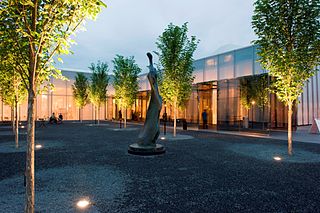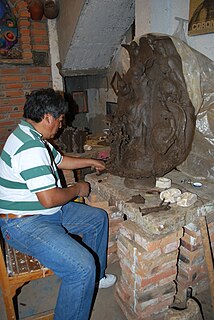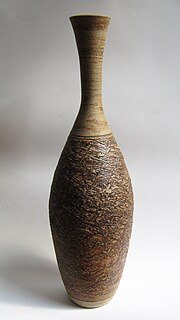Related Research Articles

Granville County is a county located on the northern border of the U.S. state of North Carolina. As of the 2010 Census, the population was 59,916. Its county seat is Oxford.

Cumberland County is a county located in the U.S. state of North Carolina. As of the 2010 census, the population was 319,431, making it the fifth-most populous county in North Carolina. Its county seat is Fayetteville. Cumberland County is part of the Fayetteville, NC Metropolitan Statistical Area.

Studio pottery is pottery made by professional and amateur artists or artisans working alone or in small groups, making unique items or short runs. Typically, all stages of manufacture are carried out by the artists themselves. Studio pottery includes functional wares such as tableware and cookware, and non-functional wares such as sculpture, with vases and bowls covering the middle ground, often being used only for display. Studio potters can be referred to as ceramic artists, ceramists, ceramicists or as an artist who uses clay as a medium.

Hans Coper, was an influential German-born British studio potter. His work is often coupled with that of Lucie Rie due to their close association, even though their best known work differs dramatically, with Rie's being less sculptural, while Coper's was much more abstract, but also always functional. The latter point was noted by M. S. Thomas in his recent book "The Essential Potness." Coper always made functional vessels, principally containers for flowers (vases), fruit (bowls), candles including work for Coventry Cathedral and Sussex University meeting house. He made a small group of Figures in the fifties, which were not vessels and were never put on sale.

Dame Lucie Rie, was an Austrian-born British studio potter.

The North Carolina Museum of Art (NCMA) is an art museum in Raleigh, North Carolina. It opened in 1956 as the first major museum collection in the country to be formed by state legislation and funding. Since the initial 1947 appropriation that established its collection, the Museum has continued to be a model of enlightened public policy with free admission to the permanent collection. Today, it encompasses a collection that spans more than 5,000 years of artistic work from antiquity to the present, an amphitheater for outdoor performances, and a variety of celebrated exhibitions and public programs. The Museum features over 40 galleries as well as more than a dozen major works of art in the nation's largest museum park with 164-acres. One of the leading art museums in the American South, the NCMA recently completed a major expansion winning international acclaim for innovative approaches to energy-efficient design.

The North Carolina Museum of Natural Sciences (NCMNS) is located in Raleigh, North Carolina as the oldest established museum in North Carolina and the largest museum of its kind in the Southeastern United States. With about 1.2 million visitors annually, as of 2013 it was the state's most popular museum or historic destination among visitors.

Edwin Scheier was an American artist, best known for his ceramic works with his wife, Mary Scheier.

David Drake, also known as "Dave Pottery" and "Dave the Potter," was an American potter and enslaved African American who lived in Edgefield, South Carolina. Drake lived and worked in Edgefield for almost all his life.
The Mint Museum, also referred to as The Mint Museums, is a cultural institution comprising two museums, located in Charlotte, North Carolina. The Mint Museum Randolph and Mint Museum Uptown, together these two locations have hundreds of collections showcasing art and design from around the globe.

Erect, North Carolina is an unincorporated community in Randolph County, North Carolina, United States, and part of the Piedmont Triad metropolitan region. Erect is located on NC 42, seven miles east of the North Carolina Zoo in Asheboro, and two miles west of Coleridge. Erect was founded in the 18th century by German and English settlers, along with the nearby communities of Steeds, Sophia, Whynot, Hemp, and Lonely. Many of these settlers were known for their pottery-making skills. A post office called Erect was established in 1883, and remained in operation until it was discontinued in 1935. In 1889, Erect had a population of 39 inhabitants.
Mark Hewitt is an English studio potter living in the small town of Pittsboro, North Carolina outside of Chapel Hill, North Carolina. In 2015 he received a United States Artist Fellowship, for contributions to the creative landscape and arts ecosystems of the country. He was a finalist for the 2015 Balvenie Rare Craft Fellowship Award, for contributions to the maintenance and revival of traditional or rare craft techniques. In 2014 he was awarded a Voulkos Fellowship at the Archie Bray Foundation for the Ceramic Arts in Helena, Montana, for outstanding contributions to the ceramic arts.

Cedar Creek Gallery is a fine craft gallery located in Creedmoor, North Carolina. Craftspeople work alongside each other, fire wood and gas fired kilns, blow glass and make a living as artists onsite. Cedar Creek Pottery and Gallery was started in 1968 by Sid and Pat Oakley on what used to be an old tobacco field. The Gallery has grown from one building into over ten since then. The grounds are well maintained with many plants, flowers and trees.

The Soteno family of Metepec is one of the main families of ceramic artisans specializing in sculptures called Trees of Life which have made the town found in the State of Mexico one of Mexico’s main ceramic centers. The Tree of Life is a complicated colorful sculpture which was developed from the creation of candlesticks. The family’s prominence began with Modesta Fernández Mata, the mother, grandmother and great-grandmother of the Soteno potters today, who began experimenting making more decorative items along with utilitarian ones. The generations after her have learned the craft and improved on it starting as children working with parents and grandparents. The two most notable members of the family are Tiburcio and Oscar, second and third generation respectively, who have won various awards and have their works in collections worldwide.

Ian Barry Brickell was a New Zealand potter, writer, conservationist and founder of Driving Creek Railway.

Ian Broun Sprague (1920–1994) was an Australian twentieth century studio potter, ceramic sculptor and graphic artist. Delayed by the Second World War and a false start in architecture, he spent (broadly) his forties adapting Australian domestic pottery to a Japanese aesthetic of contemplative use; his fifties as a sculptor in two and three dimensional pottery; his sixties and seventies making landscape works on paper.
John Parker Glick was an American ceramicist. Though open to artistic experimentation, Glick was most influenced by the styles and aesthetics of Asian pottery—an inspiration that shows in his use of decorative patterns and glaze choices. His experience working with ceramics led him to publish several articles about the craft. In addition to producing pottery, Glick began making "landscape oriented" wall panels during the latter part of his career. Known as "the people's potter," he is primarily remembered for his contributions to art and the field of ceramics.
Karl Martz was an American studio potter, ceramic artist, and teacher whose work achieved national and international recognition.

The Coxwold Pottery was a pottery studio based in the village of Coxwold, North Yorkshire, England, launched by artist potters Peter and Jill Dick in 1965, and in operation until 2012.
Michael Sherrill is an American ceramist and sculptor. Primarily self-taught, Sherrill’s early work in the 1970s and 1980s focused on creating functional pieces in clay before turning to sculptural artwork in porcelain and metal in the 1990s. Sherrill lives and works in Bat Cave, North Carolina.
References
- ↑ Mark, Rebecca (2004). The South. ISBN 9780313327346 . Retrieved 25 April 2012.
- ↑ Pitzer, Sarah (18 November 2008). North Carolina Off the Beaten Path, 9th: A Guide to Unique Places. ISBN 9780762752331 . Retrieved 25 April 2012.
- ↑ "Museums". Ceramics Today. Retrieved 25 April 2012.
- ↑ "The Museum of American Pottery". Learn NC. Retrieved 25 April 2012.
- ↑ "Art Museums". NC ECHO. Retrieved 25 April 2012.